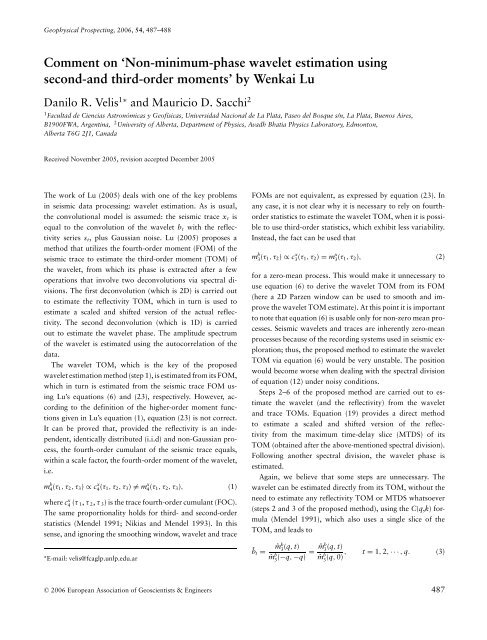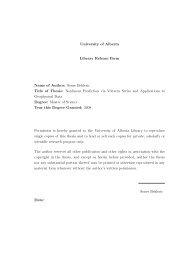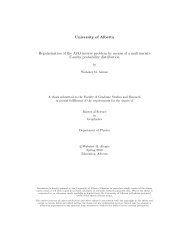Comment on 'Non-minimum-phase wavelet estimation using second ...
Comment on 'Non-minimum-phase wavelet estimation using second ...
Comment on 'Non-minimum-phase wavelet estimation using second ...
You also want an ePaper? Increase the reach of your titles
YUMPU automatically turns print PDFs into web optimized ePapers that Google loves.
Geophysical Prospecting, 2006, 54, 487–488<br />
<str<strong>on</strong>g>Comment</str<strong>on</strong>g> <strong>on</strong> ‘N<strong>on</strong>-<strong>minimum</strong>-<strong>phase</strong> <strong>wavelet</strong> estimati<strong>on</strong> <strong>using</strong><br />
sec<strong>on</strong>d-and third-order moments’ by Wenkai Lu<br />
Danilo R. Velis 1∗ and Mauricio D. Sacchi 2<br />
1 Facultad de Ciencias Astr<strong>on</strong>ómicas y Geofísicas, Universidad Naci<strong>on</strong>al de La Plata, Paseo del Bosque s/n, La Plata, Buenos Aires,<br />
B1900FWA, Argentina, 2 University of Alberta, Department of Physics, Avadh Bhatia Physics Laboratory, Edm<strong>on</strong>t<strong>on</strong>,<br />
Alberta T6G 2J1, Canada<br />
Received November 2005, revisi<strong>on</strong> accepted December 2005<br />
The work of Lu (2005) deals with <strong>on</strong>e of the key problems<br />
in seismic data processing: <strong>wavelet</strong> estimati<strong>on</strong>. As is usual,<br />
the c<strong>on</strong>voluti<strong>on</strong>al model is assumed: the seismic trace xt is<br />
equal to the c<strong>on</strong>voluti<strong>on</strong> of the <strong>wavelet</strong> bt with the reflectivity<br />
series st, plus Gaussian noise. Lu (2005) proposes a<br />
method that utilizes the fourth-order moment (FOM) of the<br />
seismic trace to estimate the third-order moment (TOM) of<br />
the <strong>wavelet</strong>, from which its <strong>phase</strong> is extracted after a few<br />
operati<strong>on</strong>s that involve two dec<strong>on</strong>voluti<strong>on</strong>s via spectral divisi<strong>on</strong>s.<br />
The first dec<strong>on</strong>voluti<strong>on</strong> (which is 2D) is carried out<br />
to estimate the reflectivity TOM, which in turn is used to<br />
estimate a scaled and shifted versi<strong>on</strong> of the actual reflectivity.<br />
The sec<strong>on</strong>d dec<strong>on</strong>voluti<strong>on</strong> (which is 1D) is carried<br />
out to estimate the <strong>wavelet</strong> <strong>phase</strong>. The amplitude spectrum<br />
of the <strong>wavelet</strong> is estimated <strong>using</strong> the autocorrelati<strong>on</strong> of the<br />
data.<br />
The <strong>wavelet</strong> TOM, which is the key of the proposed<br />
<strong>wavelet</strong> estimati<strong>on</strong> method (step 1), is estimated from its FOM,<br />
which in turn is estimated from the seismic trace FOM <strong>using</strong><br />
Lu’s equati<strong>on</strong>s (6) and (23), respectively. However, according<br />
to the definiti<strong>on</strong> of the higher-order moment functi<strong>on</strong>s<br />
given in Lu’s equati<strong>on</strong> (1), equati<strong>on</strong> (23) is not correct.<br />
It can be proved that, provided the reflectivity is an independent,<br />
identically distributed (i.i.d) and n<strong>on</strong>-Gaussian process,<br />
the fourth-order cumulant of the seismic trace equals,<br />
within a scale factor, the fourth-order moment of the <strong>wavelet</strong>,<br />
i.e.<br />
m b<br />
4 (τ1,τ2,τ3) ∝ c x<br />
4 (τ1,τ2,τ3) = m x<br />
4 (τ1,τ2,τ3), (1)<br />
where c x 4 (τ 1, τ 2, τ 3) is the trace fourth-order cumulant (FOC).<br />
The same proporti<strong>on</strong>ality holds for third- and sec<strong>on</strong>d-order<br />
statistics (Mendel 1991; Nikias and Mendel 1993). In this<br />
sense, and ignoring the smoothing window, <strong>wavelet</strong> and trace<br />
∗ E-mail: velis@fcaglp.unlp.edu.ar<br />
FOMs are not equivalent, as expressed by equati<strong>on</strong> (23). In<br />
any case, it is not clear why it is necessary to rely <strong>on</strong> fourthorder<br />
statistics to estimate the <strong>wavelet</strong> TOM, when it is possible<br />
to use third-order statistics, which exhibit less variability.<br />
Instead, the fact can be used that<br />
m b<br />
3 (τ1,τ2) ∝ c x<br />
3 (τ1,τ2) = m x<br />
3 (τ1,τ2), (2)<br />
for a zero-mean process. This would make it unnecessary to<br />
use equati<strong>on</strong> (6) to derive the <strong>wavelet</strong> TOM from its FOM<br />
(here a 2D Parzen window can be used to smooth and improve<br />
the <strong>wavelet</strong> TOM estimate). At this point it is important<br />
to note that equati<strong>on</strong> (6) is usable <strong>on</strong>ly for n<strong>on</strong>-zero mean processes.<br />
Seismic <strong>wavelet</strong>s and traces are inherently zero-mean<br />
processes because of the recording systems used in seismic explorati<strong>on</strong>;<br />
thus, the proposed method to estimate the <strong>wavelet</strong><br />
TOM via equati<strong>on</strong> (6) would be very unstable. The positi<strong>on</strong><br />
would become worse when dealing with the spectral divisi<strong>on</strong><br />
of equati<strong>on</strong> (12) under noisy c<strong>on</strong>diti<strong>on</strong>s.<br />
Steps 2–6 of the proposed method are carried out to estimate<br />
the <strong>wavelet</strong> (and the reflectivity) from the <strong>wavelet</strong><br />
and trace TOMs. Equati<strong>on</strong> (19) provides a direct method<br />
to estimate a scaled and shifted versi<strong>on</strong> of the reflectivity<br />
from the maximum time-delay slice (MTDS) of its<br />
TOM (obtained after the above-menti<strong>on</strong>ed spectral divisi<strong>on</strong>).<br />
Following another spectral divisi<strong>on</strong>, the <strong>wavelet</strong> <strong>phase</strong> is<br />
estimated.<br />
Again, we believe that some steps are unnecessary. The<br />
<strong>wavelet</strong> can be estimated directly from its TOM, without the<br />
need to estimate any reflectivity TOM or MTDS whatsoever<br />
(steps 2 and 3 of the proposed method), <strong>using</strong> the C(q,k) formula<br />
(Mendel 1991), which also uses a single slice of the<br />
TOM, and leads to<br />
ˆbt =<br />
ˆmb 3 (q, t) ˆmb 3 (q, t)<br />
=<br />
(−q, −q) ˆm b , t = 1, 2, ···, q. (3)<br />
(q, 0)<br />
C○ 2006 European Associati<strong>on</strong> of Geoscientists & Engineers 487<br />
ˆm b<br />
3<br />
3
488 Danilo R. Velis and Mauricio D. Sacchi<br />
There are also some equivalent formulae based <strong>on</strong> fourthorder<br />
statistics.<br />
However, direct methods based <strong>on</strong> a single slice of higherorder<br />
covariance or moment functi<strong>on</strong>s do not provide any<br />
filtering to reduce the effects of the errors derived from the<br />
fact that these functi<strong>on</strong>s are simple estimates, thus the above<br />
equati<strong>on</strong> is not practical from a computati<strong>on</strong>al point of view<br />
(Mendel 1991). The same argument applies to the estimati<strong>on</strong><br />
of the reflectivity <strong>using</strong> the MTDS.<br />
REFERENCES<br />
Lu W. 2005. N<strong>on</strong>-<strong>minimum</strong>-<strong>phase</strong> <strong>wavelet</strong> estimati<strong>on</strong> <strong>using</strong> sec<strong>on</strong>dand<br />
third-order moments. Geophysical Prospecting 53, 149–<br />
158.<br />
Mendel J. 1991. Tutorial <strong>on</strong> higher-order statistics in signal processing<br />
and system theory: Theoretical results and some applicati<strong>on</strong>s.<br />
Proceedings of the IEEE 79, 278–305.<br />
Nikias C.L. and Mendel J.M. 1993. Signal processing with<br />
higher-order spectra. IEEE Signal Processing Magazine 10, 10–<br />
37.<br />
C○ 2006 European Associati<strong>on</strong> of Geoscientists & Engineers, Geophysical Prospecting, 54, 487–488









